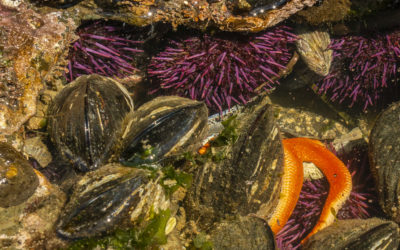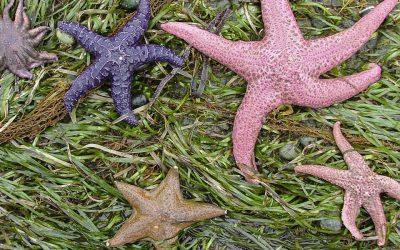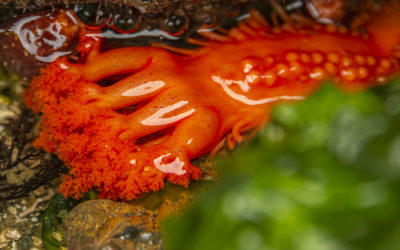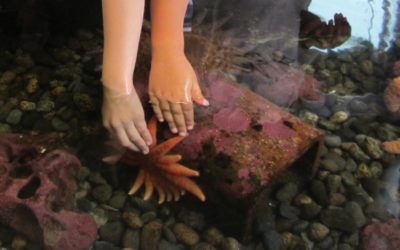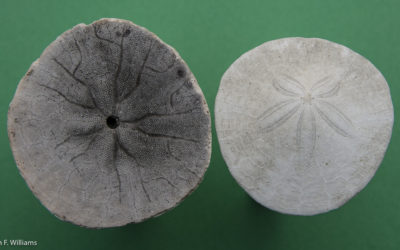Tide Pool Seaweed
by Sara Noland
Photos & video by John F. Williams except where noted
Photo by Tom Noland
It’s low tide on a lovely Pacific Northwest afternoon. The beach is an expanse of rippled mud and sand, with cobbles and scattered boulders near the water’s edge. I’ve forgotten my boots, but determined to do some beachcombing anyway, I wander between rocks and shallow pools, trying to keep my shoes dry and to not slip on the patches of green and brown slime that are everywhere. The slime is seaweed lending a bit of color to the gray mud and a salty tang to the spring breeze. Peering into a tide pool, I see the slime transformed into the graceful fronds of seaweed buoyed by water.
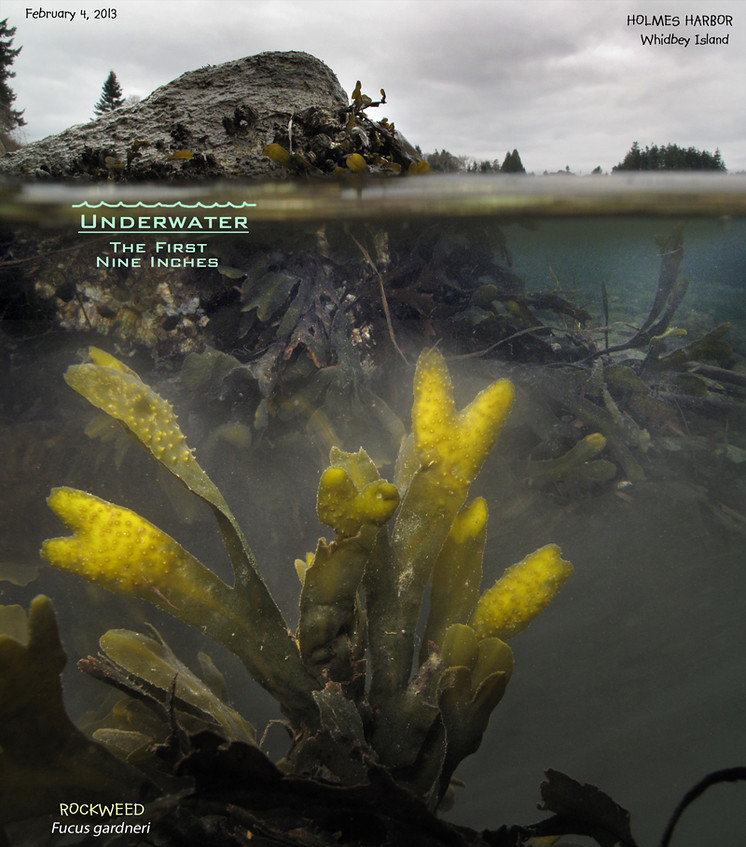
Photo by Jan Kocian
By looking into tidepools we have a chance to see the diversity of colors, shapes, sizes, and textures of seaweeds in their underwater habitat. More than just slime on the sand or a slippery coating on rocks, these plants are integral to the ecology of Puget Sound shorelines. Getting to know the common species has enriched my visits and helped me think more deeply about interactions among rocks, seaweeds, and other intertidal creatures, including beach-walking humans. The term “seaweed” is a general name for plants that grow in salt water; it includes grass-like plants such as eelgrass as well as all sizes of algae, ranging from microscopic to large enough to form underwater forests. I like to use the term “marine algae” to talk about seaweeds visible in tide pools.
Marine algae are essential to food webs along our coast. Like plants on land, they are the “primary producers” that harness sunlight to create food for animals. In addition, marine algae provide settling and hiding places that are especially important to young creatures avoiding predators or seeking refuge from heavy waves or hot sun. As professor Trevor A. Norton at the University of Liverpool put it, marine algae “provide food for herbivores, a sheltering breakwater when the tide is in, and a moist protective blanket when the tide is out. The ecological importance of seaweed beds is therefore immense.”
Lacking the woody framework of terrestrial plants, with no stiff trunks or branches to support them, marine algae droop when out of water. But underwater they are well adapted to their marine environment. A part of the algae called the “holdfast” attaches to the substrate, which is usually a rock but can also be another seaweed or even the shell of a crab or snail. The holdfast keeps the algae from being washed away by the currents and the flexible algal fronds (or blades) allow them to bend and move with the waves.
Marine algae holdfasts, used to anchor the plants to hard surfaces like rocks. Photo by Nancy Sefton
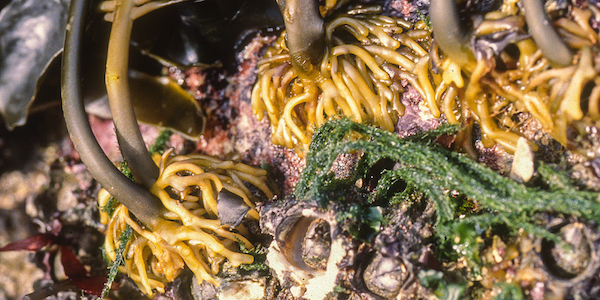
Marine algae holdfasts, used to anchor the plants to hard surfaces like rocks. Photo by Nancy Sefton
The type of shoreline you’re visiting—whether a quiet bay or a wave-swept outcropping, a rocky shore or a sandy flat—has a major influence on the species of algae you’re likely to see. On any particular beach, the patterns of marine algae depend largely on tidal elevation, where organisms are almost always underwater at the lowest tide zones, sometimes exposed to air during low tides at middle zones, or often exposed at the highest zones. Even localized factors like sun versus shade or the amount of wave splash reaching a particular rock are important in determining which algae can live there. Don’t be disappointed if you visit the beach in winter and don’t see a lot of algae. Like other plants, marine algae tend to be most visible and abundant during the spring and summer.
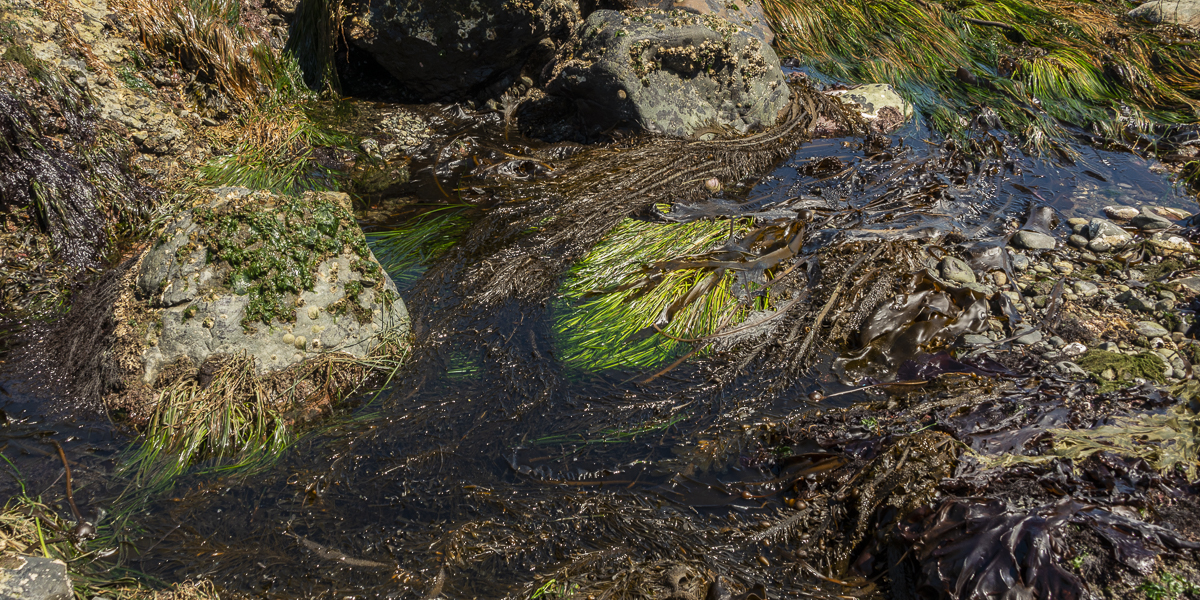
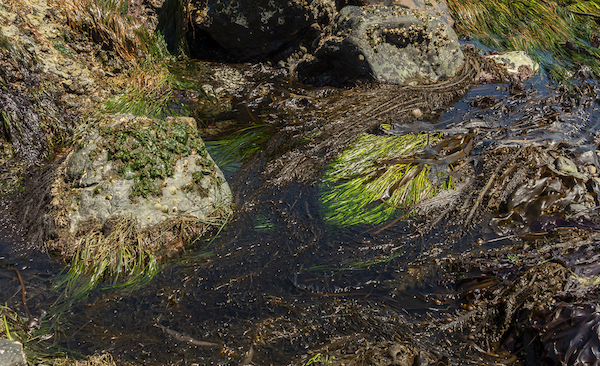
The marine algae you’ll see on a visit to tidepools around Puget Sound fall into three groups: green, brown, and red. All contain chlorophyll, the pigment that allows plants to perform photosynthesis and gives them their green color. Brown and red algae also contain other types of pigments that give them their different colors.
Because color alone is not a reliable indicator of taxonomy, scientists categorize algae by considering features such as reproductive structures, growth patterns, and how the plant stores food. An alga in the red group may look brown or even black if it’s dried out during low tide.
Photos courtesy of Sara Noland
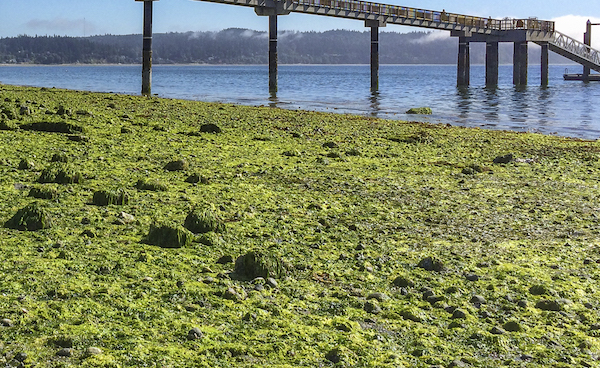
greens
One of the most common green algae on local beaches is sea lettuce (in the genus Ulva). You can find it attached to rocks in the middle to upper tide zone, or as free-floating plants in quiet tide pools. Found worldwide, sea lettuce has been used as mulch, animal food, and even as a condiment in soups and salads. Ulva is one of the culprits in “green tides,” a bloom of excess algae on some Puget Sound beaches that happens during the late summer or fall. As the algal blanket decomposes in the sun, it not only smells like rotten eggs, it also uses up dissolved oxygen and nutrients needed by other species, causes changes in pH, and can release chemical substances that are toxic to other creatures. I prefer to observe this species in the spring when I can appreciate its bright green blades against rain-darkened rocks.
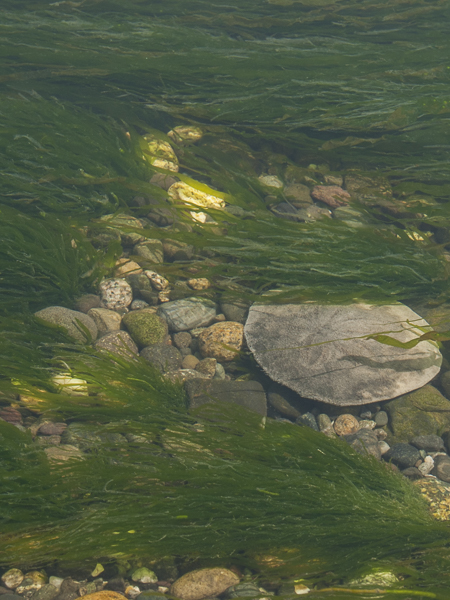
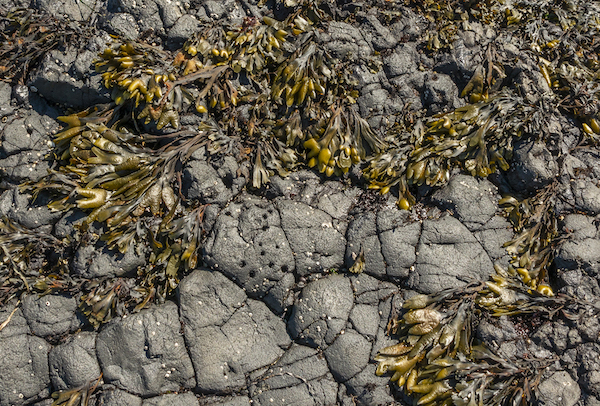
browns
Among the browns, you’re sure to find rockweed (genus Fucus) covering the rocks on almost any rocky Puget Sound beach. Also called bladder wrack, this brown algae ranges from the low tide zone all the way to upper zone rocks where it’s too high and dry for other seaweeds. Its distinctive olive-green branches have bladders at the ends containing a mucous-like gel (this is where the reproductive cells are made). After hours in the summer sun, rockweed turns dark green or almost black. Northwest Coast tribes made good use of rockweed, piling it over hot rocks to create steam for cooking and squeezing the gel from its bladders for use as a salve. With Fucus found in temperate areas worldwide, it’s also been used for garden mulch, cattle fodder, and as a source of products such as alginate. Like other marine algae, Fucus provides habitat for many creatures, even fish. For example, on the beaches around Vancouver, Canada, sharpnose sculpin are known to use Fucus as a cover for their egg masses, to keep the eggs from drying out during low tide.
Video of rockweed swaying in the tidepool, floats holding the branches high. Video by Nancy Sefton
reds
The red algae include some of the most delicate seaweeds. To distinguish among all the small, feathery red species requires practice (and in some cases a microscope), but I always enjoy their beauty even if I can’t readily name them. Larger red algae in the genus Porphyra are easier to identify, growing on rocks in the low to mid tide zones, often mixed with Fucus. In tide pools its thin, wide blades float like sheets of silk, while out of water it resembles wrinkled handkerchiefs hanging from the rocks, or if it’s severely dried out, a brittle piece of cellophane. Coast Salish tribes harvested Porphyra as food and later for trade, preparing it through fermenting or drying. Porphyra has also been used as food by Europeans (who know it as laver) and in Asia (where it’s called nori). In case you decide to try Porphyra (or any algae) on your own plate, be sure to follow state harvest rules and avoid polluted areas.
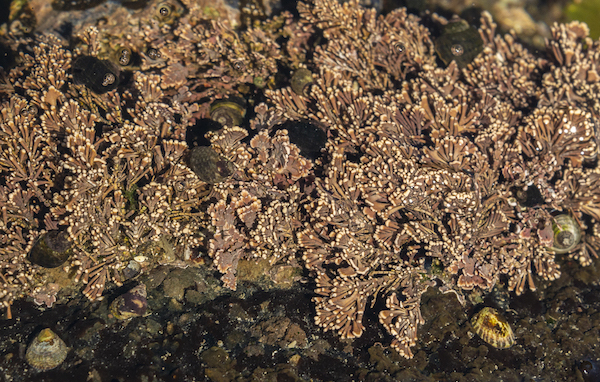
corallines
The coralline algae are a special group, not common on all beaches but worth the search to find them. Until the 1800s scientists weren’t sure whether coralline algae were in fact coral animals or plants. We now know they are a type of red algae that sequester calcium carbonate in their cell walls, creating a hard outer coating. They occur in two forms: crustose and articulated. The crustose forms often look like pink splashes of paint on the rocks, while articulated species are upright and branching. Branching corallines are segmented, with uncalcified or soft spaces between the calcified or hard areas, allowing them to flex and bend with the waves. Corallines cannot withstand long periods out of water, so look for them at very low tide or in shady rock crevices. They also tend to inhabit shorelines with vigorous waves.
survival tactics
When I see algae left high and dry on rocks during low tide, I’m always amazed they can survive. Dehydration-tolerant species inhabiting the upper tide zone may lose 90 percent of their cellular water when exposed to air during a low tide. How do they recover? Research has shown a complex system of strategies ranging from stiffening algal cell walls to reducing photosynthesis during dry periods. When the tide returns, these species rehydrate quickly and can do so a couple of times a day.
Like other creatures, marine algae have to reproduce, which can be a challenge in the changing environment of the intertidal zone. Crack open a book on marine algae and you’ll probably find a section about their life cycles—I recommend Common Seaweeds of the Pacific Coast by J. Robert Waaland as a good introduction with helpful examples and diagrams. Most marine algae alternate between sexual and asexual generations.
In some species, such as sea lettuce, the two types of generations look very similar (both basic fronds). However, in other algae the two generations are so dissimilar that people used to consider them separate species. One example is nori (Porphyra), which alternates between the familiar red fronds described earlier and a small filamentous form that was thought to be a different species (Conchocelis) until the 1940s. Another common marine alga with bizarre alternating forms is bull kelp (Nerocystis); this species spends part of the year as an inconspicuous group of cells (the sexual phase) that after fertilization grow into the large bulb-headed fronds (asexual phase) we often see tossed up on the beach. Yet another example is Turkish washcloth (Mastocarpus), a red alga with small branching fronds that earns its name by being covered in rough bumps that give it a washcloth texture. Its complex life cycle includes another phase that looks like purple or black tar on the rocks, also long thought to be a separate species (Petrocelis).
Like other ocean species, marine algae are at risk from ocean acidification. This phenomenon is caused by rising levels of carbon dioxide in the atmosphere. When dissolved in seawater, carbon dioxide forms an acid that alters the chemical balance of the sea. Coralline algae are of particular concern because they are slow growing, widespread, and dependent on calcium carbonate, which becomes less available to them as seawater becomes more acidic.
Why do we care what happens to any marine algae? It goes back to the web of life that we all learned about: where everything is connected to, affected by, and has an effect on everything else — including human beings. One of the most notable functions of algae is that it produces more than half the world’s oxygen through photosynthesis. This process also converts atmospheric carbon dioxide into food for other sea creatures, earning it an indispensable role in the planetary food web. In addition to providing a food source for other marine animals, birds, and even people, the larger algae provide safe habitat for a wide variety of marine organisms. We’re just at the beginning of the learning curve in our understanding of algae’s role in marine ecology, but we do know that, if algae ceased to exist, the consequences would be grave indeed. When you walk the beach and wonder at the wide array of algae populating every moist nook and cranny, you might consider how much all life on earth depends on these simple, beautiful and ubiquitous creatures.
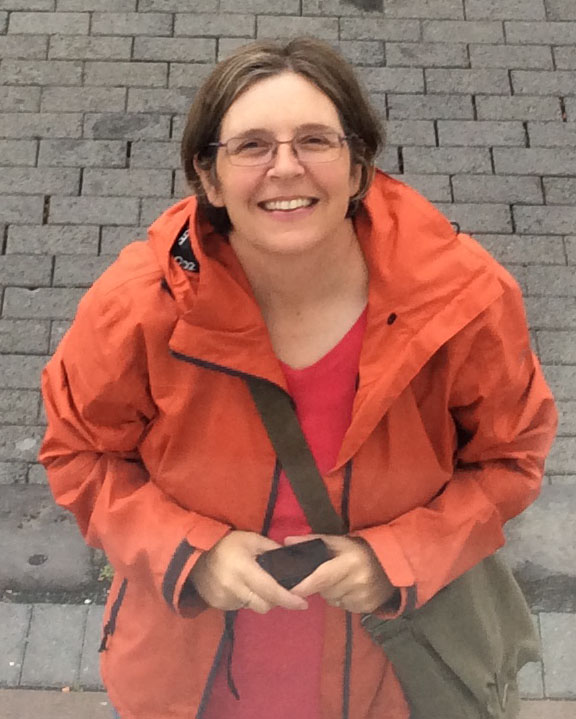
Table of Contents, Issue #4, Summer 2019
Windows On the Sea
by Nancy Sefton Photos & video by John F. Williams except where notedBy Nancy Sefton, Summer 2019 Photos & video by John F. Williams except where notedI am bent over double, unable to stop a steady slide down a slope of green slime, tennies soaking, shoulders...
Star Eat Star World
by Paul Pegany Photos & video by John F. Williams except where notedSome of the variety of local sea stars. Photo by Sharon PeganySome of the variety of local sea stars. Photo by Sharon PeganyBy Paul Pegany, Summer 2019 Photos & video by John F. Williams...
Sea Cucumbers
by Paul Pegany Photos & video by John F. Williams, except where notedBy Paul Pegany, Summer 2019 Photos & video by John F. Williams except where notedSea cucumbers are elongated creatures with a mouth on one end and an anus on the other. They appear soft,...
Salish Sea Tide Pools
by Adrianne Lauman, Summer 2019 Photos & video by John F. Williams except where notedBy Adrianne Lauman, Summer 2019 Photos & video by John F. Williams except where notedA tide pool is created when a small amount of marine water is left on a shoreline or in...
Portals of Discovery
by Sharon Pegany Photos & video by John F. Williams except where notedImage courtesy of Feiro Marine Life CenterImage courtesy of Feiro Marine Life CenterBy Sharon Pegany, Summer 2019 Photos & video by John F. Williams except where notedAs spring gives way to...
Postscript 4
by John F. Williams Photos & video by John F. Williams except where notedBy John F. Williams, Summer 2019 Photos & video by John F. Williams except where notedThis issue marks a full year of publishing for Salish Magazine! I've learned a lot of lessons, and a...
FIND OUT MORE
Best, R.J., A.L. Chaudoin, M.E.S. Bracken, M.H. Graham, and J.J. Stachowicz. 2014. Plant–animal diversity relationships in a rocky intertidal system depend on invertebrate body size and algal cover. Ecology, 95(5): 1308–1322.
Contreras-Porcia, Loretto, Camilo López-Cristoffanini, Andrés Meynard, and Manoj Kumar. 2017. Tolerance pathways to dessication stress in seaweeds. Chapter 2 in M. Kumar and P. Ralph (eds.), Systems Biology of Marine Ecosystems. Springer International Publishing.
Fisher, K., and P.T. Martone. 2014. Field study of growth and calcification rates of three species of articulated coralline algae in British Columbia, Canada. Biol. Bull. 226: 121-130.
Guenther, Rebecca. 2016. The Effect of Temperature and pH on the Growth and Biomechanics of Coralline Algae. Ph.D. Thesis, University of British Columbia, Vancouver.
Huggett, J., and C.L. Griffiths. 1986. Some relationships between elevation, physicochemical variables and biota of intertidal rock pools. Mar. Ecol. Prog. Ser. 29: 189-197.
Jensen, S.L., and G. Muller-Parker. 1994. Inorganic nutrient fluxes in anemone-dominated tide pools. Pacific Science 48(1): 32-43.
Johansen, H.W. 1981. Coralline Algae, A First Synthesis. CRC Press, Boca Raton, FL.
Kocian, Jan. An underwater photographer who augments his photos with artwork to add context and interpretation. His gallery The First 9 Inches Underwater is especially relevant to this Tide Pool issue of Salish Magazine
Kozloff, Eugene N. 1983. Seashore Life of the Northern Pacific Coast: An Illustrated Guide to Northern California, Oregon, Washington, and British Columbia. University of Washington Press, Seattle.
Little, C., G. A. Williams, and C.D. Trowbridge. 2006. The Biology of Rocky Shores, Second Edition. Biology of Habitats Series. Oxford University Press.
Marliave, J.B. 1981. High intertidal spawning under rockweed, Fucus distichus, by the sharpnose sculpin, Clinocottus acuticeps. Canadian Journal of Zoology, 1981, 59(6): 1122-1125.
McCoy, S.J. and C.A. Pfister. 2014. Historical comparisons reveal altered competitive interactions in a guild of crustose coralline algae. Ecology Letters (2014) 17: 475-483.
McCoy, S.J. and M.A. Kamenos. 2018. Coralline algal skeletal mineralogy affects grazer impacts. Global Change Biology 2018; 24:4775–4783.
Neuman, Melissa J., Susan Wang, Shallin Busch, Carolyn Friedman, Kristen Gruenthal, et al. 2018. A Status Review of Pinto Abalone (Haliotis kamtschatkana) Along the West Coastof North America: Interpreting Trends, Addressing Uncertainty, and Assessing Risk for a Wide-Ranging Marine Invertebrate. Journal of Shellfish Research 37(4): 869-910.
Norton, T.A. 1986. The zonation of seaweeds on rocky shores. Chapter II in The Ecology of Rocky Coasts: essays presented to J.R. Lewis. Edited by P.G. Moore and R. Seed. Columbia University Press, New York.
Ragazzola, F., L.C. Foster, A. Form, P.S.L. Anderson, T.H. Hansteen, and J. Fietzke. 2012. Ocean acidification weakens the structural integrity of coralline algae. Global Change Biology (2012) 18, 2804–2812.
Singh, R.P. and C.R.K. Reddy. 2014. Seaweed–microbial interactions: key functions of seaweed-associated bacteria. FEMS Microbiology Ecology 88 (2014): 213–230.
Slater Museum of Natural History, University of Puget SoundSlater Museum of Natural History, University of Puget Sound has web pages about many marine creatures, including:
- Turkish Washcloth or Black Tar Spot (Mastocarpus papillatus)
- Rockweed (Fucus distichus)
Stephenson, T.A., A. Zoond, and J. Eyre. 1934. The liberation and utilisation of oxygen by the population of rock-pools. Journal of Experimental Biology 11: 162-172.
Turner, Nancy J. 1995. Food Plants of Coastal First Peoples. Royal BC Museum, Victoria, British Columbia.
Turner, Nancy J. 1998. Plant Technology of First Peoples in British Columbia. Royal BC Museum, Victoria, British Columbia.
Turner, Nancy J. and Richard J. Hebda. Saanich Ethnobotany. 2012. Royal BC Museum, Victoria, British Columbia.
Van Alstyne, K.A., T. A. Nelson, and R.L. Ridgway. 2015. Environmental Chemistry and Chemical Ecology of ‘‘Green Tide’’ Seaweed Blooms. Integrative and Comparative Biology 55 (3): 518–532.
Waaland, Robert. 1977. Common Seaweeds of the Pacific Coast. Pacific Search Press, Seattle.
Yiu, D.S. and C. J. Feehan. 2017. Articulated coralline algae provide a spatial refuge to juvenile sea urchins from predatory crabs. Mar. Biol. Short Notes 164:76.

